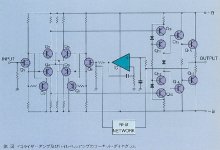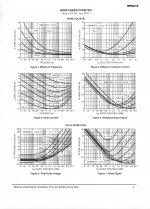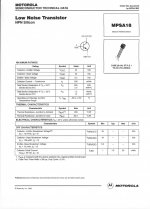T, further consideration of the circuit that you just put up shows a true engineer's understanding of the problems, and a practical solution that could have been effected even in the middle 1960's without too much of a problem, since the 2N3819 was available even then.
John,
In my opinion, the information about the circuit ThorstenL posted is a bit misleading. I think it is his own variation on the themes "Sansui's way of pulling BJT bases apart" + "Borbely style 2nd stage" + "a tad of LH0033".
As far as I know, Accuphase never used that type of 2nd stage and they only used Jfet in front of comp.diff. input stage to (my guess) solve coupling caps / input Z issues. And no 2N3819's, by the way, just some 2SKxx.
I might be wrong, but then, ThorstenL is welcome to correct me and provide a reference. 😉
Best,
Attachments
Elektroj, this is called 'quibbling' or making much of what you see, different, when it is really very similar. The 2N3819 has an American number, so the Japanese are not generally going to use it. However, it is a very old part and often sourced from many places.
I know, John, it is. 😀Elektroj, this is called 'quibbling' <snip>
But then, it is not fair to come up with some self-brewed schematic and call it someone else's.
What's your own position with numerous clones and variations of your products, by the way? Are they allowed to bear "designed by John Curl" tag?
(flame trousers on)
Best,
T's circuit is just an improved variation of what you put up. The essence of what T started from is contained in your schematic. It is good for a designer to give 'prior art' some recognition.
Hi,
Perhaps. There are many influences in this.
I'm not particulary on Sansui, this is more Diamond transistor influenced.
The key to me are N-Channel J-Fet buffering symmetrical differentials.
These come from Accuphase. I do not claim the circuit is an exact copy of Accuphase's designs and the parts are based on what is inside of Tina-Ti and many others could be used. The VAS Stage is what I considered adding and has it's own advantages. Accuphase used a normal darlington VAS in the schematic I looked at E-305).
The circuit is about showing a principle, not a precise and exact implementation.
Ciao T
In my opinion, the information about the circuit ThorstenL posted is a bit misleading. I think it is his own variation on the themes "Sansui's way of pulling BJT bases apart" + "Borbely style 2nd stage" + "a tad of LH0033".
Perhaps. There are many influences in this.
I'm not particulary on Sansui, this is more Diamond transistor influenced.
The key to me are N-Channel J-Fet buffering symmetrical differentials.
These come from Accuphase. I do not claim the circuit is an exact copy of Accuphase's designs and the parts are based on what is inside of Tina-Ti and many others could be used. The VAS Stage is what I considered adding and has it's own advantages. Accuphase used a normal darlington VAS in the schematic I looked at E-305).
The circuit is about showing a principle, not a precise and exact implementation.
Ciao T
Hi,
I was giving credit to the originators of the idea, in case the concept of crediting sources of inspiration is alien to you.
Some people...
Ciao T
But then, it is not fair to come up with some self-brewed schematic and call it someone else's.
I was giving credit to the originators of the idea, in case the concept of crediting sources of inspiration is alien to you.
Some people...

Ciao T
Scott, it is obvious that you have not lived with a Quan-Tech noise analyzer on a daily basis for most of your life.
Perhaps you should look over his article in Linear Audio v3 giving noise measurements for high impedance sources.
I was giving credit to the originators of the idea <snip>
ThorstenL,
You weren't giving credit to originators of the idea, you published schematic and attributed it to Accuphase,
whereas in reality it only remotely resembled their product.BTW, I cannot really claim that one, it's earlyish lower end Accuphase...
This is not the best practice to credit sources, I must say. Just use the proper wording and it will be fine.
Something similar to this would be much better:
"I did some thinking about this and came up with this... The idea to use Jfets in front of complementary differential stage came from manufacturer XXX."
Also, by keeping out words that describe from which end in your opinion the product might be, you will refrain from offending anyone.
Enough of this.
Let's stop tooting our own horns and get back to analysis of John Curls works, before he has changed his mind.
Best,
I hope to point out Noise Figure (a useful figure of merit in this case) with current with a typical low noise input transistor. Please note what happens with increasing current.
I was not talking typical, I was refering to the devices I mentioned last week. How to make bi-polars that are still improving beyond 25mA was demonstrated (and actually put into the public domain) over 25yr. ago. Unfortunately there was no money in this and no one ever used this information. Yes the application space is narrow.
EDIT - MPSA18 a choice for low noise input ???? If this is meant to dissipate confusion go for it.
Last edited:
If to take Thorsten't input stage and bootstrap JFET followers like Sansui did I would like it even more.
The MPSA18 is related to the 2N5210, which is complementary to the 2N5087. These are devices that we used more than 40 years ago for input stages. That is WHY they have a WHOLE PAGE devoted to Noise Figure. However, look what happens when you run at 10ma or more. That is why I put it up. These devices normally have a beta between 250 and 500 or so, which lowers the base current. They are fairly high voltage, and their rbb' is slightly on the high side, but typical for this range of devices.
OF COURSE, you can insist on a complementary pair, low Rbb' device with a similar voltage rating and a beta of about 500. I might sell a few to some serious customers. Not cheaply, though. Not made anymore.
It would be a waste of device, since Rs will probably be more than 100 ohms and typically 1K ohm. Then you are in trouble.
OF COURSE, you can insist on a complementary pair, low Rbb' device with a similar voltage rating and a beta of about 500. I might sell a few to some serious customers. Not cheaply, though. Not made anymore.
It would be a waste of device, since Rs will probably be more than 100 ohms and typically 1K ohm. Then you are in trouble.
Everyone, please note what type of transistor this is defined as by the manufacturer. There are 'better' devices, but they are not available anymore.
Hi,
Please upgrade your reading and interpretative skills and stop making silly claims.
If you misunderstood what I wrote, tough...
Ciao T
You weren't giving credit to originators of the idea, you published schematic and attributed it to Accuphase,
Please upgrade your reading and interpretative skills and stop making silly claims.
If you misunderstood what I wrote, tough...
Ciao T
In any case, there are usually better ways to make a low noise input than a comp. diff. bipolar transistor array, even though it can be made quiet enough for most uses.
In late 70'th I found that this transistor works better in mic preamp than specialized low-noise transistors.
The guy who designed it in our Tomsk Institute said that he did spiral shape of emitter because it looked better, but I think it was a joke. 😉
It is КТ-626, high frequency medium power transistor.
An externally hosted image should be here but it was not working when we last tested it.
The guy who designed it in our Tomsk Institute said that he did spiral shape of emitter because it looked better, but I think it was a joke. 😉
It is КТ-626, high frequency medium power transistor.
Yes, Wavebourn, many medium power transistors work well enough for low noise inputs. I used the Fairchild 8050 and 8550 two amp complementary output transistors in the late 70's in the Sota MC Head Amp, and got 0.4nV/rt Hz.
Yes, Wavebourn, many medium power transistors work well enough for low noise inputs. I used the Fairchild 8050 and 8550 two amp complementary output transistors in the late 70's in the Sota MC Head Amp, and got 0.4nV/rt Hz.
Similar devices are still available.
I might point out that while some 'unusual' devices might work OK for a MC pre-preamp, they would usually make poor candidates for a general purpose complementary differential stage, being discussed here at the moment. This is because of other compromises, such a low beta or low maximum voltage, or both. Practical designers cannot always get in quantity the 'ideal' parts for a product, and we have to find reasonable substitutes.
Perhaps an example of a 'super device' complementary pair is the Toshiba 2SA1316/2SC3329 parts-pair. These parts do just about everything right: Low Rbb', relatively high voltage, very high beta, etc. Unfortunately, they are hard to find.
In future, we will be stuck with GENERIC devices like the MPS-A18,2N5087, etc. it would seem.
Perhaps an example of a 'super device' complementary pair is the Toshiba 2SA1316/2SC3329 parts-pair. These parts do just about everything right: Low Rbb', relatively high voltage, very high beta, etc. Unfortunately, they are hard to find.
In future, we will be stuck with GENERIC devices like the MPS-A18,2N5087, etc. it would seem.
- Status
- Not open for further replies.
- Home
- Member Areas
- The Lounge
- John Curl's Blowtorch preamplifier part II


